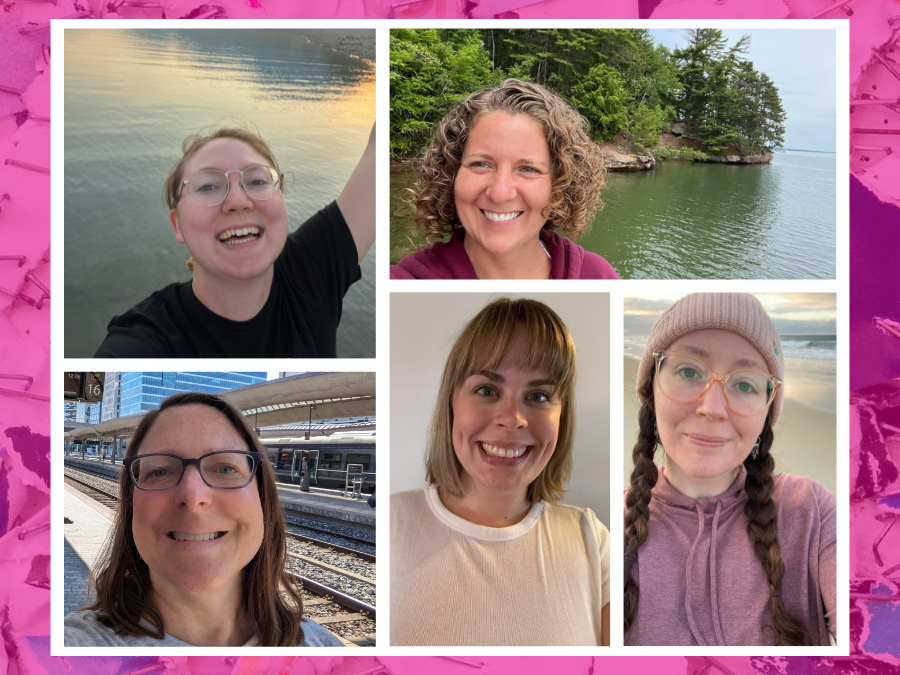
Saint Paul, Minnesota T4BL Study Group Members
The Saint Paul, Minnesota, Teaching for Black Lives study group formed in 2021 and participated through the 2022–2023 school year. Fourteen educators from Community of Peace Academy met monthly in-person. According to Maija Kittleson Wilker, 7th-grade math teacher and study group coordinator, a goal for their second year was to take action by “sharing our learning with our community, and I think we accomplished that — though the work is never done, of course!”
Study group members facilitated Professional Learning Community (PLC) sessions for elementary, middle, and high school teachers at Community of Peace Academy. During these sessions they shared articles from Teaching for Black Lives and modeled lessons they came upon throughout their study group participation. Kittleson Wilker shared,
I learned about the First Conversations books through the Black Lives Matter at School curriculum fair, organized by the D.C. Area Educators for Social Justice (DCAESJ). I shared Our Skin: A First Conversation About Race with study group members and we explored the teaching guide that goes along with it. For the PLC session in May, the group decided to model an ethics lesson centered around a read-aloud of Our Skin and used some of the teaching ideas as mini-lessons that can be integrated in our classrooms.
I was able to try the lesson with a small group of students — from an after-school leadership club — before the group modeled it. The discussion with students after reading Our Skin was rich both in what they noticed and what it motivated me to do. After we identified different types of racism, I had the students dial in on the examples they identified at school so that we could think about potential actions we could take.
One example was the “unfair treatment of rowdy students.” When I asked them to be more specific about who the rowdy students were, they said they were usually Black students. Students said that they saw (or experienced it) and knew it was unfair but they weren’t sure what to do about it. Thinking about potential actions they could take was difficult because the work is really on the teachers and administration. Something students could do was to tell a trusted teacher what they experienced and advocate for their classmates by making sure both/all sides of a story get told in the case of a fight or larger altercation.
This activity really motivated me to keep doing the work that I am doing, both with my students and my colleagues. Students need a space to discuss and contextualize racism and teachers need space to unpack biases and learn how to be better. Piloting it with the students was helpful because I was able to show my colleagues that our students are ready to and want to have these conversations.
“It might be hard and you might be learning with your students but trying something is better than doing nothing and the students will appreciate that you are doing something,” said one of my colleagues at the end of our lesson.
Additional PLC presentations included reading and discussing “What Do You Mean When You Say Urban?,” guiding the planning of Black Lives Matter at School week of action, and breaking down the principles and demands of the Black Lives Matter movement. The study group asked participants to complete an evaluation form after the presentations. One question asked what they thought about teaching ethnic studies in elementary school. A participant shared,
We’re not teaching as much as we’d like to. It’s not in the curriculum explicitly. As teachers we don’t feel confident teaching on this topic since we’d have to make up materials on our own. It’s a lot to take on and is intimidating because it’s such an important area — we might not do it justice or teach comprehensively enough.
Kittleson Wilker concluded, “Teachers overwhelmingly said they wanted more support with incorporating ethnic studies in the elementary classroom. That wasn’t something we were able to directly address in sessions during the rest of the year, but something we want to work on during the 2023–2024 school year.”

